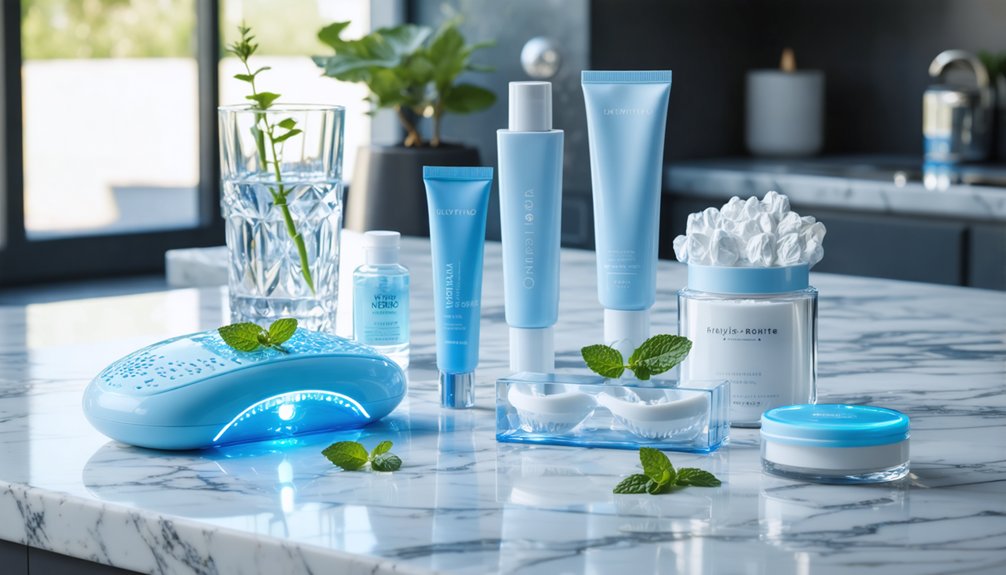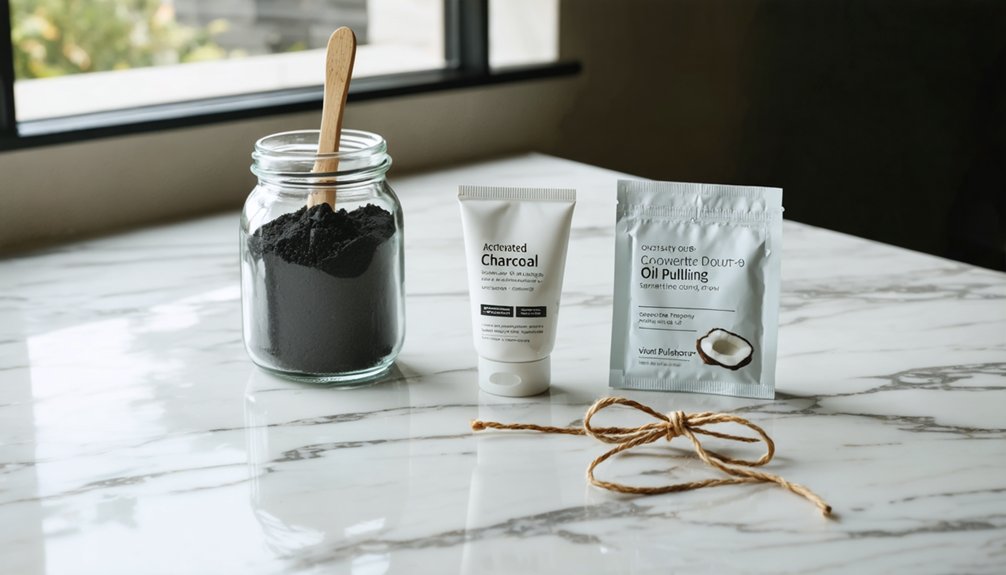If you have sensitive teeth, start with a professional dental evaluation before whitening. Choose products containing lower concentrations (10-15%) of hydrogen peroxide or gentle carbamide peroxide alternatives specifically formulated for sensitivity. Use custom-fitted trays with desensitizing agents, and maintain shorter application times with recovery intervals between sessions. Apply fluoride treatments and desensitizing gels before and after whitening. Following a thorough protocol will help you achieve ideal results while protecting your enamel integrity.
Key Takeaways
- Choose whitening products specifically designed for sensitive teeth with lower peroxide concentrations (10-15%) and built-in desensitizing agents.
- Apply desensitizing agents 1-2 weeks before treatment and continue using them throughout the whitening process.
- Use custom-fitted trays correctly to prevent gel migration and ensure even distribution while avoiding gum irritation.
- Schedule multiple short whitening sessions instead of long ones to allow enamel recovery time between treatments.
- Maintain good oral hygiene and avoid acidic foods, extreme temperatures, and staining agents during and after treatment.
Understanding Sensitive Teeth and Whitening Compatibility
When considering teeth whitening with sensitive teeth, it’s crucial to understand how your oral condition interacts with bleaching agents. Common sensitivity triggers include exposed dentin, weakened enamel, and gum recession, which can intensify during whitening procedures.
Before starting any whitening treatment, recognize that sensitive teeth require special consideration to avoid intensifying existing discomfort through bleaching procedures.
Contrary to whitening myths, you don’t need high-concentration peroxide products for effective results. Your teeth’s sensitivity level directly impacts which whitening methods you can safely use. Zoom whitening treatments offer a controlled, professional approach for those with sensitivity concerns. Research shows that one in eight Americans experience tooth sensitivity, making careful treatment selection essential.
Professional evaluation helps identify underlying causes and determines appropriate treatment options. If you’re prone to sensitivity, consider peroxide-free alternatives like PAP or products containing potassium nitrate and stannous fluoride.
Custom-fit trays from your dentist offer better control and minimize gum irritation compared to over-the-counter strips, which often cause heightened discomfort due to poor fit and excessive bleaching agent exposure.
Essential Pre-Treatment Preparation Steps
Before undertaking any teeth whitening procedure with sensitive teeth, you’ll need to complete several essential preparatory steps to optimize treatment success and minimize discomfort.
The pre-treatment importance begins with a thorough sensitivity assessment by your dental professional to evaluate enamel integrity and identify specific areas of concern. Calcium phosphate treatments help remineralize tooth enamel and provide additional protection before whitening begins. Working with your dentist to select the right whitening method ensures optimal results for sensitive teeth.
- Schedule a detailed dental evaluation to detect underlying issues that could compromise whitening success and establish a customized treatment protocol for your sensitivity level.
- Begin using prescribed desensitizing agents 1-2 weeks before treatment, including specialized toothpaste containing potassium nitrate or professional fluoride applications.
- Implement strict oral hygiene protocols and dietary modifications, eliminating acidic foods and beverages while maintaining consistent use of a soft-bristled toothbrush and sensitivity-formulated oral care products.
Choosing the Right Whitening Products for Sensitive Teeth
Selecting appropriate whitening products for sensitive teeth requires careful consideration of active ingredients, formulation strengths, and application methods to guarantee ideal results while minimizing discomfort.
Choose teeth whitening products wisely by evaluating ingredients and application methods to achieve optimal results without triggering sensitivity issues.
You’ll want to focus on product formulations containing lower concentrations of hydrogen peroxide (10-15%) or gentle carbamide peroxide alternatives. Look for items specifically labeled for sensitive teeth that incorporate desensitizing agents like potassium nitrate or fluoride. Many patients with existing tooth sensitivity should undergo a dental exam before starting any whitening treatment.
While reviewing consumer reviews, pay attention to LED whitening kits with mild gels, as they can provide accelerated results with reduced irritation. Good Housekeeping notes that LED light technology enhances whitening effectiveness while remaining gentle on sensitive teeth. Custom-fit trays or precision applicator pens offer targeted treatment while minimizing gum contact.
For superior safety, choose whitening strips or toothpastes designed explicitly for sensitivity, and verify that products include built-in desensitizers to protect your enamel during treatment.
Safe Application Methods to Minimize Discomfort
To minimize sensitivity during teeth whitening, you’ll need to carefully control application times and follow prescribed intervals between sessions, allowing your teeth adequate recovery periods. Using products with lower peroxide levels can significantly reduce tooth sensitivity while still being effective.
Your custom-fitted whitening tray should create a precise seal that prevents gel migration while ensuring even distribution of the whitening agent across tooth surfaces.
Integrating desensitizing treatments before and after each whitening session creates protective barriers that greatly reduce nerve stimulation and enamel wear. Choosing whitening products containing potassium nitrate helps block pain signals while achieving your desired level of brightness.
Gentle Application Time Control
When managing teeth whitening for sensitive teeth, precise control of application duration serves as a critical factor in minimizing discomfort and protecting enamel integrity. Choose products containing potassium nitrate ingredients to help reduce tooth sensitivity while whitening. Following dentist guidance is essential for determining the safest whitening approach for your specific sensitivity level.
Apply gentle pressure during shorter treatment intervals of 15-30 minutes, making timing adjustments based on your sensitivity response. You’ll achieve ideal results while safeguarding your dental health by implementing controlled exposure protocols.
- Monitor your treatment duration meticulously, starting with 10-15 minute sessions to assess tolerance.
- Space your whitening sessions at least 48 hours apart to allow proper enamel recovery.
- Discontinue application immediately if you experience sharp or persistent pain.
Custom Tray Usage Tips
Since custom tray application represents a critical component of safe teeth whitening, proper usage techniques can greatly minimize discomfort for sensitive teeth.
With your custom tray design, apply a small, continuous bead of whitening gel about 1/3 to 1/2 the length of the syringe along the front surface only. Guarantee even distribution while avoiding overfilling, which can cause gum irritation.
For ideal tray fitting, press the appliance gently but firmly over your teeth without forcing it. Don’t attempt to adjust the tray’s shape at home, as this can compromise its effectiveness and increase sensitivity.
Store your trays in a clean, dry container between uses, and clean them with cool water and a soft toothbrush after each session. Regular inspection for cracks or warping will help maintain proper fit and prevent tissue trauma.
Desensitizing Treatment Integration
Proper desensitizing treatment integration plays an essential role in successful teeth whitening for sensitive patients. By combining professional fluoride treatments with targeted desensitizing gels, you’ll create an effective barrier against sensitivity while achieving peak whitening results.
Follow precise application protocols and maintain consistent monitoring throughout the treatment process to guarantee patient comfort and safety.
- Apply prescribed desensitizing gels evenly across tooth surfaces, avoiding gingival tissue contact to prevent mucosal irritation.
- Schedule multiple short sessions rather than lengthy treatments to allow proper enamel recovery time.
- Monitor tooth hydration levels continuously, as dehydrated teeth considerably increase sensitivity risks.
Always maintain strict adherence to manufacturer guidelines while customizing treatment protocols based on individual sensitivity levels.
Use soft-bristled toothbrushes and incorporate regular fluoride treatments to strengthen enamel throughout the whitening process.
Post-Whitening Care and Recovery Guidelines
After completing a teeth whitening treatment, following specific post-care guidelines becomes essential to minimize sensitivity and maximize results.
You’ll need to modify your post whitening diet by avoiding temperature extremes and acidic foods for 24-48 hours. Stick to room-temperature, soft foods while your enamel recovers.
For sensitivity relief, use desensitizing toothpaste containing potassium nitrate before and after treatment. You can take over-the-counter pain relievers if discomfort persists.
Continue your oral hygiene routine using a soft-bristled brush, but avoid aggressive brushing immediately after treatment. Focus on gentle cleaning techniques and incorporate fluoride products to strengthen your enamel.
If sensitivity lasts beyond a week, consult your dentist for professional evaluation and additional treatment options.
Long-Term Maintenance and Prevention Strategies

To maintain your whitening results and prevent future stains, you’ll need to implement consistent protective measures in your daily oral care routine.
You can preserve your brightened smile by avoiding staining agents like coffee, tea, and red wine while incorporating specialized whitening toothpaste formulated for sensitive teeth.
Regular use of fluoride-containing products and pH-balancing rinses will strengthen your enamel while protecting against new discoloration and sensitivity.
Prevent Future Tooth Stains
Maintaining white teeth requires an extensive approach that combines dietary modifications, consistent oral hygiene practices, and protective measures against staining agents.
You’ll need to adjust your dietary habits by limiting chromogen-rich foods and using straws for acidic beverages. Proper oral hygiene, including twice-daily brushing with sensitive-formulated whitening toothpaste and daily flossing, is essential for preventing stain accumulation.
- Rinse your mouth immediately after consuming staining foods or beverages to prevent pigment adherence.
- Choose alcohol-free mouthwash and soft-bristled toothbrushes to protect sensitive enamel.
- Maintain ideal hydration to support natural saliva production, which helps inhibit stain formation.
Schedule regular dental check-ups and consider professional treatments like fluoride varnish to strengthen your enamel against future staining.
Sustain Whitening Results Naturally
While preserving whitening results demands consistency, natural maintenance strategies can effectively sustain your bright smile without aggravating tooth sensitivity.
Implement dietary changes by incorporating calcium-rich foods and crunchy vegetables that naturally cleanse teeth. You’ll strengthen your enamel while promoting saliva production through foods like apples, carrots, and leafy greens. Drink water after meals to rinse away potential staining agents.
Among natural remedies, rotate gentle methods weekly to prevent cumulative wear. Consider oil pulling with coconut oil, occasional turmeric-coconut oil paste applications, or mild baking soda treatments. Monitor your teeth’s response and adjust frequency accordingly.
Schedule regular dental checkups to assess enamel health and sensitivity levels. Remember to wait 30 minutes after consuming acidic foods before brushing to protect your enamel’s integrity.
Natural and Alternative Whitening Solutions
Seeking gentler alternatives to traditional teeth whitening methods can be essential for those with sensitive teeth.
Oil pulling with coconut oil offers a safe daily option, utilizing lauric acid’s antimicrobial properties to reduce plaque without harsh chemicals.
While baking soda combined with hydrogen peroxide can remove surface stains, you’ll need to exercise caution to prevent enamel erosion.
- You’re protecting your patients’ dental health by recommending specialized whitening toothpastes formulated for sensitivity rather than acidic fruit applications.
- You’re preventing further damage by steering them away from citrus-based DIY treatments that can irreversibly harm enamel.
- You’re empowering your patients with sustainable whitening practices through proper hygiene and dietary choices that naturally maintain tooth brightness.
Frequently Asked Questions
Can I Whiten My Teeth While Wearing Braces or Dental Crowns?
While you’re enthusiastic to brighten your smile, braces whitening isn’t recommended as it causes uneven results. For crowns, they won’t respond to bleaching and may increase sensitivity. Wait until braces removal instead.
Will Taking Pain Medication Before Whitening Help Reduce Tooth Sensitivity?
You’ll experience better pain management by taking NSAIDs 30 minutes before whitening. While it won’t eliminate discomfort completely, this proactive approach provides significant sensitivity relief during and after your treatment.
How Long Should I Wait Between Different Whitening Treatments?
Like waiting between episodes of your favorite show, you’ll need 24-72 hours between whitening treatments. For ideal sensitivity management, consider extending intervals to weekly if your teeth are particularly sensitive.
Does Smoking Affect the Success of Teeth Whitening Treatments?
Your smoking habits greatly reduce whitening effectiveness by creating stubborn stains, forming barriers that block bleaching agents, and causing rapid re-staining. You’ll see slower, less dramatic results compared to non-smokers.
Can Certain Medications Interfere With Teeth Whitening Results?
Like a shadow over your smile, various medication types – especially tetracycline antibiotics, antihistamines, and blood pressure drugs – can greatly impact whitening effectiveness by causing intrinsic staining and altering oral chemistry.
References
- https://www.encinitascosmeticdentistry.com/practice-news/how-to-prepare-sensitive-teeth-for-whitening/
- https://www.redrocksfamilydentistry.com/teeth-whitening-options-for-sensitive-teeth/
- https://familydentistchandler.com/how-to-avoid-teeth-sensitivity-after-whitening/
- https://crest.com/en-us/oral-care-tips/teeth-whitening/teeth-whitening-sensitive-teeth
- https://www.scottgreenhalghdds.com/blog/10-tips-for-dealing-with-sensitivity-after-teeth-whitening
- https://buforddentist.com/what-are-the-best-whitening-options-for-sensitive-teeth/
- https://www.goodrx.com/conditions/dental-care/sensitive-teeth-after-whitening
- https://pmc.ncbi.nlm.nih.gov/articles/PMC4058574/
- https://www.drbobsdentalcare.com/is-teeth-whitening-safe-for-sensitive-teeth/
- https://www.purpleplumdentistry.com/post/best-teeth-whitening-options-for-sensitive-teeth



